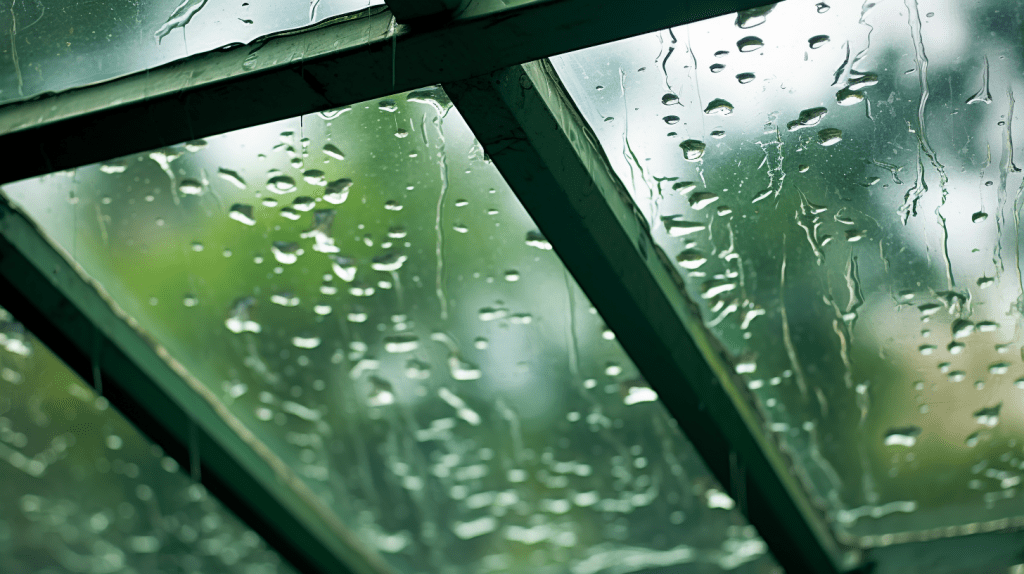A leaking conservatory is more than just an annoyance — it can lead to mould, damp, structural damage, and wasted energy if left unchecked. Whether the leak is small or recurring, knowing how to diagnose and fix the issue early can save you time, money, and stress. In this guide, we’ll walk you through the key steps: identifying the cause, choosing DIY repairs versus professional fixes, typical costs in 2025, and how to prevent future leaks.
Why Your Conservatory May Be Leaking
Several issues can cause conservatory leaks:
- Deteriorated seals at roof joints
- Blocked or damaged guttering/downpipes
- Slipped, cracked, or missing roof panels
- Damaged or poorly installed flashing where the roof meets the house
- Faulty or worn roof vents
Leaks often start small, but left unattended, they can lead to wood rot, mould growth, condensation, and even compromise your frames or insulation. Early detection and timely repair can greatly reduce disruption and long-term costs.
Identifying the Source of the Leak
1. Inspect Sealant and Joints
Sealant between roof panels and at the roof ridge may crack or degrade over time. Water often enters where the sealant has failed. Look for visual gaps, brittle or discoloured beads, especially after rainfall or in damp corners. These are usually easy to re-seal when spotted early.
2. Check Gutters and Downpipes
Blocked or sagging gutters/downpipes can overflow during rainstorms, allowing water to run behind seals or drip into frame joints. Clear debris (leaves, moss, algae) regularly and inspect for cracks or splits.
3. Examine Roof Panels
Polycarbonate or glass panels can crack, shift, or become dislodged due to wind or poor installation, leaving gaps that let water in. Look for visible cracks or panels that move under light pressure.
4. Inspect Flashing Where Roof Joins the Wall
Flashing is the critical seal between the conservatory roof and your home’s brick wall. Incorrect or damaged flashing can let rain in at joints. Check for visible gaps or poorly laid flashing sealant.
5. Review Roof Vents and Ventilation Junctions
Vent covers can degrade or misfit, particularly around ridge vents or trickle vents, causing leaks in heavy rain. Inspect and test each vent for looseness or damage.
DIY Repairs — What You Can Safely Do
Many leaking conservatory repairs are DIY-friendly if you feel confident working at height, have a safe ladder or access tower, and basic tools.
1. Reapply or Replace Sealant
Clean and dry the joint thoroughly, then apply a high‑quality UV-resistant sealant. Make sure it’s suitable for exterior use and conservatory roofing materials. This fix typically costs from £100 including sealant and tools. Read more about conservatory windows here.
2. Clear & Repair Gutters
Removing debris and flushing downpipes can prevent overflows. Damaged sections should be replaced or locally sealed. Gutter cleaning costs range around £35–£85, while minor repairs or leak tracing generally cost £100–£400 overall.
3. Replace Damaged Panels
For a cracked or slipped polycarbonate or small glass panel, replacement may be straightforward if you can access the roof safely. Panel replacements often start from £200 per panel depending on type and size.
4. Fix Flashing and Roof Vents
Minor flashing leaks can be resealed; worn sections may require replacement. Roof vent resealing or replacement may start around £200 depending on complexity and labour.
When to Call a Professional
Some situations are best handled by a trade professional:
- Multiple or recurring leaks
- Suspected structural damage, sagging roof, or frame issues
- Flashing that may require roof panel removal or rework
- After heavy weather events (storms, hail)
Structural issues or sagging roof lines
If roof glazing, trims, or framework is sagging or warped, it’s likely beyond simple DIY. Repairs can range between £2,000 and £3,000 depending on severity.
Major roof replacement
If your roof is old (10–20+ years), or repair costs become excessive, a full roof replacement may be more cost-effective. Expect £5,000–£7,000+ depending on size, material, and style.
Typical Costs for Leaking Conservatory Repairs in 2025
These UK-based cost ranges (as of 2025) can help you budget:
Minor repairs
- Re‑seal joints or re‑silicone: from £100
- Replace one or two panels: from £200 per panel
- Clean gutters/downpipes: £35–£85 or up to £400 for small repairs
Moderate repairs
- Flashing repair or replacement: around £200+, up to several hundred pounds depending on materials and access
- Sagging roof frame: £2,000–£3,000
Full roof replacement or conversion
- Glass conservatory roof replacement (standard size ~3–4 m): approximately £3,000–£5,000
- Solid/tiled or insulated roof replacement: £5,000–£7,000+ depending on complexity and materials.
Step‑by‑Step Repair Guide
Step 1: Assess and Document
- Inspect conservatory after rain
- Locate leak points using water test or daylight method (shining torch behind panels)
- Photograph problem areas
Step 2: Clean and Prepare
- Remove moss, algae, and dust from gutters and roof seams
- Dry affected areas before repair
Step 3: Carry Out Repairs
- Sealant reapplication: apply one continuous bead in dry conditions
- Panel fix/replacement: carefully remove damaged panel(s) and refit securely
- Flashing/vent work: reseal small cracks or fully replace worn flashing/vents
Step 4: Test and Monitor
- After repair, test with gentle hose spray and check for leaks
- Monitor over the next few rain incidents
Step 5: Maintain Preventatively
- Annual roof inspection
- Regular gutter cleaning
- Replace degraded sealant every few years
- Keep ventilation functional to reduce condensation-related damage
Long‑Term Considerations
1. When Replacement May Be Better
If leaks are frequent and frame or roof panels are aging, full replacement may deliver better longevity, insulation, and usability — as well as improved energy rating and property appeal.
2. Costs vs Insurance & Warranty
- Many UK home insurance policies cover sudden damage from storms — check your policy
- Manufacturer or installer warranties may still apply if your conservatory is under warranty Source
3. Plan for Better Temperature Control
If inefficiency is compounding leaks and damp, consider upgrading to a solid, insulated roof system. These deliver year‑round comfort and cut heating bills in the long run.
Taking Control of Leaks and Longevity
A leaking conservatory doesn’t need to mean constant frustration or heavy expense. With timely diagnosis, minor DIY fixes, and well‑planned professional repairs, leaks can be resolved before they lead to bigger problems. Regular maintenance, seal checks, and gutter cleaning are the most effective prevention tactics.
However, if your conservatory is older, poorly insulated, or showing recurring issues, an upgraded roof system — including solid or tiled/conversion options — may offer better long‑term comfort and value. Whether you repair leaks quickly or choose to replace, addressing the problem promptly protects your home, prevents damage, and preserves the usable life of your conservatory.

